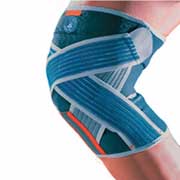Torn Cartilage & Football
May 13 2008 | Articles

Torn Cartilage Introduction
In football, torn cartilages are a prevalent form of knee injury. Despite what the name suggests, this injury actually involves damage to the Meniscus within the knee rather than the cartridge.
The use of the term ‘cartilage’ is perhaps due to the fact that the Meniscus is composed of tough fibro cartilage. Found in pairs and located within each knee joint, the Menisci have a distinct C-shape and a noticeable thickness around their rims. The menisci functions as a shock absorber, especially in activities that involve a lot of weight bearing.
With the bending of the knee joint comes in corresponding motions from the thigh bone. The thigh bone will typically roll, spin, and glide on the surface of the shin bone. However, in the event that a twist occurs while the joint is still bearing weight, there will be a rotation which can cause the Menisci to get crammed and squeezed in between the shin and thigh bone. A tear of the meniscus may happen if there is enough force from the twist.
Torn Cartilage Signs & Symptoms
Although the lack of nerve supply ensures that damage to the meniscus itself will be painless, the force of the twist will cause damage to other knee structures. The Medial Collateral Ligament (MCL) and the Coronary ligaments, the structures that fasten the Meniscus to the shin are often injured. The damage to these connective parts may cause the player’s knee joint to swell up.
A tear in the Meniscus will have a very poor chance of healing since in addition to the lack of nerve supply, there is also very limited blood supply to this area. The tear will eventually create a flap which will disrupt the normal mechanics of the joint. This condition may cause the footballers knee joint to suddenly lock in one position. Also, there will be a clunking sound present when the knee is either bent or flexed. When engaged in activities like walking downstairs, the knee may buckle and eventually give way.
Torn Cartilage Treatment
In some instances, a return to football can be immediately facilitated since the initial knee pain and swelling will eventually subside, allowing the knee joint to settle down. Such conditions are possible because of two possibilities – either the tear in the Meniscus is minimal or the flap does not disrupt the movement of the joint.
In the case of football players, surgery may be necessary to correct a flap that causes buckling or giving way of the knee. The surgery is performed arthroscopically, a procedure where the surgeon uses a small camera to help guide the use of a burring device. By removing the flap, the device will help make the surface of the meniscus smoother. After a typical overnight confinement in the hospital, the player can immediately begin rehabilitation.
The primary aim of Physiotherapy treatment is to lessen the pain caused by the inflammation of the knee. The treatment involves the application of ice packs to the knee every couple of hours, for 20 minutes each time. However, the patient must be careful since the ice packs can cause ice burns when placed directly on the skin. When used properly, the ice packs will help alleviate the pain as well as reduce bleeding within the tissue. It is recommended to use reusable ice packs. View Reusable ice packs
If there are anxieties caused by fears of the knee ‘giving way’, it would be advisable to use a knee brace since it can provide the knee joint with a certain measure of stability. Along with physiotherapy treatment, the knee brace will help the patient develop confidence in his knee joint. Modern knee braces now offer support and stability without restricting motion so they can be utilized from rehabilitation all the way up to the patient’s return to his regular athletic activities.
After the surgical wounds have healed, it is recommended for players to engage in Water Exercises or Hydrotherapy in order to maintain muscular fitness. The patient may opt to use a buoyancy aid which will enable him to do jogging motions without actually touching the pool’s bottom. This is a low-impact activity that will give the patient some cardiovascular exercise while helping him regain the knee’s normal range of motion. Pool running is an ideal post-surgery activity since it does not put any strain on the knee joint.

Click here to view buoyancy jackets for water therapy
Torn Cartilage Prevention
A torn cartilage is an injury that cannot be easily prevented. However, developing strength in the Quadriceps and in the Hamstrings may be useful in preventing the occurrence of torn cartilages.
Football Rescue Recommends Knee Supports
![]()
![]()
![]()
![]()
![]() 5 Star Rating
5 Star Rating

Excellent medial and lateral support ideal for footballers. Multi-tiered, plush-lined elastic body with wraparound design.

The Knee sport strap is designed to simulate knee joint strapping techniques used to support the collateral knee ligaments and restrict joint rotation but still enable running
